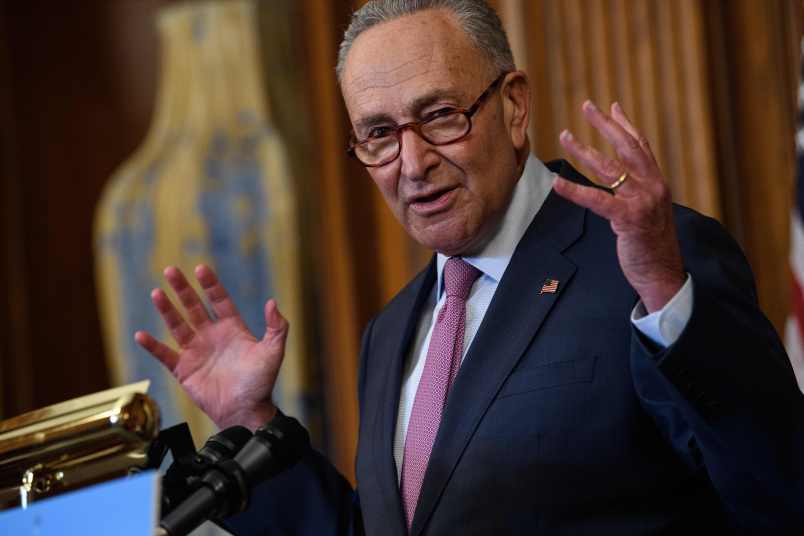At some point on January 5, Sen. Tom Udall (D-NM) will take the Senate floor and begin a process that he hopes will end in the successful use of the “Constitutional option” — the prerogative of a majority of the Senate’s members to rewrite its rules on the first day of a new Congress.
He and his allies have been vocal about their plan. But the actual sequence of events that starts with him giving a speech, and ends with filibuster reform, is obscure, fragile, and extremely complicated. In fact, it’s so involved that the “first day” of the 112th Senate could actually last for weeks.
There are myriad unknowns and X-factors that could change the course of events, and even upend Udall’s ambitions altogether. But what follows is a list of steps he and the Senate will have to take to succeed in exercising the “Constitutional option,” so called because the Constitution empowers the Senate to write its own rules.
On day one, Udall — or, perhaps, one of his allies — will take the floor, armed with a reform package, and object to the continuation of the previous Senate’s rules.
If Vice President Biden is sympathetic to Udall — a big unknown — he can chime in supportively (what’s known as an advisory opinion). That’s what Udall wants, and he’s pressing Biden to oblige him.
“The group of reform senators is going to file a brief with the Vice President letting him know what we’re going to do,” Udall told me. “In the past, three vice presidents, have issued advisory rulings at the beginning of the process.”
But the process doesn’t hang on that question.
Unfortunately for Udall, his rules package will be subject to — you guessed it — filibuster. And Republicans will filibuster. In fact their filibuster will probably carry through the end of the first week, and perhaps even a two week recess. So when his patience runs out, he’ll have to be prepared with a complicated procedural motion — a request that the rules package live or die by majority-rule, and that no intervening business interrupt debate on the reforms.
Republicans won’t take that lying down. They’ll raise what’s known as a “point of order” against Udall’s motion, objecting to one or more aspects of it. Biden would have to reject the point of order, or, more likely, let the Senate decide who’s right and who’s wrong. In that case, Democrats will have to move to table that point of order — and that only takes 51 votes.
That’s where Biden comes in again. Democrats will likely ask Biden to rule that if the point of order is set aside by the majority, it constitutes a validation of Udall’s procedural scheme. If Biden agrees, and Dems stick together, then the Constitutional option is invoked, and they’ll be on a bumpy path to amending the rules by majority vote. If he doesn’t, then the minority’s obstruction can continue.
Republicans would throw everything and the kitchen sink at this effort, and Biden could make their lives more complicated by ruling against them at some point, perhaps tanking their efforts. Or Harry Reid and Mitch McConnell could intercede and scrap the Constitutional option altogether in favor of a bipartisan package of rules changes, and the whole process will be aborted.
Reformers want to hew closely to the playbook Democrats used in 1975, when they last reformed the filibuster. Back then Democrats invoked the Constitutional option, but, after their threat was proved credible, Republicans budged and agreed to a bipartisan plan that was adopted via the more traditional rules-change process.
All make sense? Good. If you want to read an even more technical explanation of these steps, check out the below memo, passed along by a Hill source, outlining this scenario in Senate-ese.
Possible Procedure for the Constitutional Option
· On the first day of the 112th Congress, a member of the reform group would seek recognition from the Chair. Upon receiving recognition, s/he would say: “Mr. President, on behalf of the following Senators and myself, and in accordance with Article I, Section 5 of the Constitution, I send to the desk a resolution and I ask that the Clerk read it.” This would be a resolution containing the various reforms to the Senate rules.
· After the Clerk reads the Resolution, the Senator would ask unanimous consent for its immediate consideration. If there is no objection, the Resolution is on the floor for debate.
· Most likely, there would be an objection. Senate rules require 1 legislative day’s notice in writing to amend or modify a Senate rule. The Senator who offered the motion would then address the Chair and send to the desk a motion to amend a Senate rule and ask that the notice be read.
· At some point, the Senate would adjourn, rather than recess, so the reformer’s Resolution would comply with the one-day notice rule. (The Senate majority leader determines whether the Senate recesses or adjourns at the end of a day.)
· Reform Senators would need to object to any attempt to transact substantive business or seek a unanimous consent request to that effect. The objective is to ensure that the reformers do not waive any rights to amend Senate rules on opening day by majority vote. Thus, “opening day” could be extended for several days or weeks.
· On the day the Senate returns after an adjournment, the Chair would lay the Resolution before the Senate during the morning hour. At the conclusion of the morning hour, the Resolution would be placed on the calendar. At that time the sponsor of the Resolution would move that the Senate proceed to its consideration. Debate on the motion that the Senate proceed to the consideration of the Resolution would follow.
· Opponents could (a) move to table the reformer’s Resolution reaffirming the continuity of Senate rules; (b) move to refer the Resolution to the Committee on Rules and Administration; (c) defeat the motion to call up the Resolution; (d) reject the Resolution outright; or (e) raise a constitutional point of order against the Resolution. Assuming there is a majority in favor of reform, all of these tactics would fail.
· The constitutional challenge would likely come if a filibuster is launched against either the motion to call up the Resolution or on the Resolution itself. After a reasonable period of debate, a member of the reform group would move to cut off debate by a simple majority vote. A point of order would likely be made that the move to cut off debate is contrary to the continuous nature of Senate rules. The Chair would submit the point of order to the Senate because it raises a constitutional question. The point of order is debatable.
· As occurred three times in 1975, a majority could vote to table the point of order, thus upholding the right of a simple majority to end debate on a rules change.
· Throughout these procedural steps, there would be negotiations on the rules reforms that might be able to pass with a supermajority. This is how the filibuster rule was amended in 1959 and 1975 – the looming threat of a majority vote on cloture forced a compromise.










